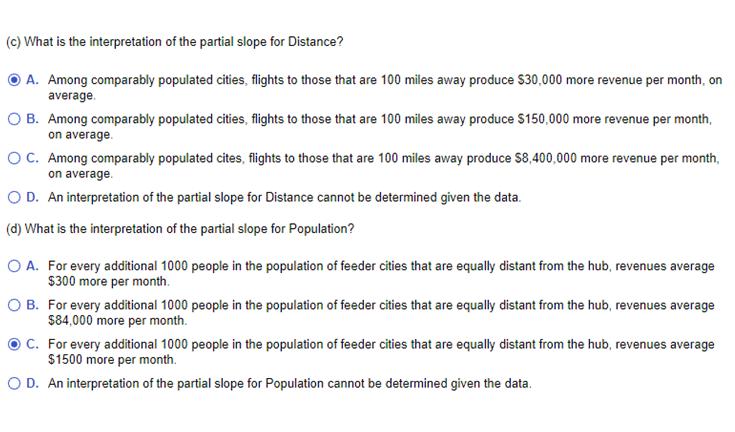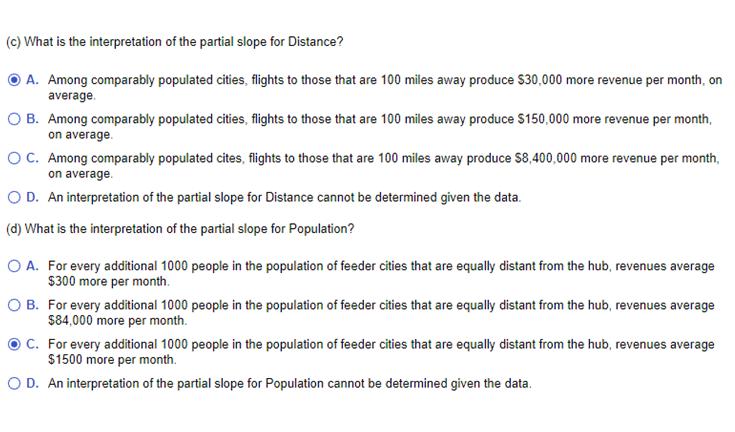Answered step by step
Verified Expert Solution
Question
1 Approved Answer
An airline developed a regression model to predict revenue from flights that connect feeder cities to its hub airport. The response in the model



An airline developed a regression model to predict revenue from flights that connect "feeder cities to its hub airport. The response in the model is the revenue generated by flights operating to the feeder cities (in thousands of dollars per month), and the two explanatory variables are the air distance between the hub and feeder city (Distance, in miles) and the population of the feeder city (in thousands). The least squares regression equation based on data for 37 feeder locations last month is Estimated revenue = 84 +0.3Distance +1.5Population with R = 0.72 and s, 30.1. Complete parts a through d. (a) The airline plans to expand its operations to add an additional feeder city. The first possible city has population 100,000 and is 250 miles from the hub. A second possible city has population 130.000 and is 225 miles from the hub. Which would you recommend if the airline wants to increase total revenue? The second city O The first city (b) What is the interpretation of the intercept in this equation? OA. The intercept estimates fixed revenue based upon the distance between the hub and feeder city. B. The intercept estimates fixed revenue based upon the population of the feeder city. C. The intercept estimates fixed revenue regardless of distance or population, such as earnings from air freight D. An interpretation of the intercept cannot be determined given the data. (c) What is the interpretation of the partial slope for Distance? A. Among comparably populated cities, flights to those that are 100 miles away produce $30,000 more revenue per month, on average. O B. Among comparably populated cities, flights to those that are 100 miles away produce $150,000 more revenue per month, on average. O C. Among comparably populated cites, flights to those that are 100 miles away produce $8,400,000 more revenue per month, on average. OD. An interpretation of the partial slope for Distance cannot be determined given the data. (d) What is the interpretation of the partial slope for Population? O A. For every additional 1000 people in the population of feeder cities that are equally distant from the hub, revenues average $300 more per month. OB. For every additional 1000 people in the population of feeder cities that are equally distant from the hub, revenues average $84,000 more per month. C. For every additional 1000 people in the population of feeder cities that are equally distant from the hub, revenues average $1500 more per month. O D. An interpretation of the partial slope for Population cannot be determined given the data. (c) What is the interpretation of the partial slope for Distance? A. Among comparably populated cities, flights to those that are 100 miles away produce $30,000 more revenue per month, on average. O B. Among comparably populated cities, flights to those that are 100 miles away produce $150,000 more revenue per month, on average. O C. Among comparably populated cites, flights to those that are 100 miles away produce $8,400,000 more revenue per month, on average. OD. An interpretation of the partial slope for Distance cannot be determined given the data. (d) What is the interpretation of the partial slope for Population? O A. For every additional 1000 people in the population of feeder cities that are equally distant from the hub, revenues average $300 more per month. OB. For every additional 1000 people in the population of feeder cities that are equally distant from the hub, revenues average $84,000 more per month. C. For every additional 1000 people in the population of feeder cities that are equally distant from the hub, revenues average $1500 more per month. O D. An interpretation of the partial slope for Population cannot be determined given the data.
Step by Step Solution
★★★★★
3.43 Rating (162 Votes )
There are 3 Steps involved in it
Step: 1
Answer a The airline should expand its operations to add the second city because it is closer to the hub and has a larger population b The intercept estimates the fixed revenue regardless of distance ...
Get Instant Access to Expert-Tailored Solutions
See step-by-step solutions with expert insights and AI powered tools for academic success
Step: 2

Step: 3

Ace Your Homework with AI
Get the answers you need in no time with our AI-driven, step-by-step assistance
Get Started


